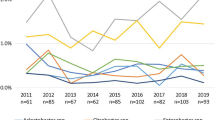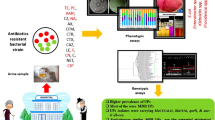Abstract
Ureaplasma urealyticum is considered as a species which is intrinsically sensitive to macrolides (MIC < 1 μg/ml). Nevertheless, some of the strains recently isolated in our laboratories showed moderate to high levels of resistance (MICs ranging from 2 μg/ml to 100 pg/ml). In particular, a strain (CT28) isolated from a patient with nongonococcal urethritis long treated with erythromycin revealed a MIC > 100 μg/ml for this antibiotic. In order to investigate the mechanisms of resistance, strain CT28 and ten clinical and laboratory U. urealyticum strains were compared for the sensitivity to six antibiotics including three macrolides. Moreover the amount of macrolide uptake and the specific antibiotic binding to ribosomes were studied.
Strain CT28 was resistant to josamycin, erythromycin, roxithromycin, lincomycin and clindamycin but sensitive to minocycline. When compared to a sensitive strain, strain CT28 showed a six-fold reduction in intracellular macrolide influx and accumulation and a reduction in antibiotic binding to ribosomes. The mechanisms implicated in these differences may be important for macrolide resistance in U. urealyticum.
Similar content being viewed by others
References
Arthur M., Brisson-Noel A. and Courvalin P. (1987): Origin and evolution of genes specifying resistance to macrolide, lincosamide and streptogramin antibiotics: data and hypotheses. - J. Antimicrob. Chemother 20: 783–802.
Bebear C., Aparicio M., Clerc M., Renaudin H. and Potaux L. (1984): Comparative bacteriological and chemical analysis of kidney calculi. A propos of 135 cases. - Nephrologie. 5 (5): 225–227.
Belt J.A. (1983): Heterogeneity of nucleoside transport in mammalian cells two types of transport activity in L1210 and other cultured neoplastic cells. -Mol. Pharmacol. 24: 479–484.
Black F. (1973): Biological and physical properties of human T-mycoplasmas. - Ann. N.Y. Acad. Sci. 225: 131–143.
Bradford M.M. (1976): A rapid and sensitive method for the quantitation of microgram quantities of protein utilizing the principle of protein-dye binding.- Analy. Biochem. 72: 248–254.
Braun P., Klein J.O. and Kass E.M. (1970): Susceptibility of genital mycoplasmas to antimicrobial agents. - Appl. Microbiol. 19: 62–70.
Brown J.T. and Roberts M.C. (1987): Cloning and characterization of tetM gene from a Ureaplasma urealyticum strain. - Antimicrob. Agents Chemother. 31 (11): 1852–1854
Brunner H. and Laber G. (1985): Chemotherapy of mycoplasma infections, p. 403–450. In RazinS. and BarileM.F. (ed.), The Mycoplasmas, Vol. 4 Academic Press, New York.
Burdett V. (1986): Streptococcal tetracycline resistance mediated at the level of protein synthesis. -J. Bacteriol. 165: 564–569.
Cassell G.H., Clyde W.A., Kenny Jr. G.E., McCormack W.M. and Taylor-Robinson D. (ed) (1986): Ureaplasmas of humans: with emphasis upon maternal and neonatal infections. - Pediat. Infect. Dis. 5: 51–5354.
Cassell G.H., Waites K.B., Crouse D.T., Rudd P.T., Canupp K.C., Stagno S. and Cutter G.R. (1988): Association of Ureaplasma urealyticum infection of the lower respiratory tract with chronic lung disease and death in very-low-birth-weight infants. - Lancet 2 (8605): 240–245.
Clewell D.B. and Gawron-Burke C. (1986): Conjugative transposons and the dissemination of antibiotic resistance in streptococci. - Ann. Rev. Microb. 40: 635–659.
Courvalin P., Ounissi H. and Arthur M. (1985): Multiplicity of macrolide - lincosamide -streptogramin antibiotic resistance determinants. - J. Antimicrob. Chemother. 16: 91–100.
Davis J.W. and Hanna B.A. (1981): Antimicrobial susceptibility of Ureaplasma urealyticum. - J. Clin. Microbiol. 13: 320–325.
Ettayebi M., Prasad S.M. and Morgan E.A. (1985): Chloramphenicol-erythromycin resistance mutations in a 23S rRNA gene of Escherichia coli. - J. Bacteriol. 162: 551–557.
Garland S.M. and Murton L.J. (1987): Neonatal meningitis caused by Ureaplasma urealyticum. -Pediatr. Infect. Dis. 6: 868–869.
Grabowski M.W., Rottem S. and Barile M.F. (1976): Cholesterol requirements of mycoplasmas as determined by a microtiter test using polyene antibiotics. - J. Clin. Microbiol. 3: 110–112.
Hachler H., Kayser F.H. and Berger-Bachi B. (1987): Homology of a transferable tetracycline resistance determinant of Clostridium difficile with Streptococcus (Enterococcus) faecalis transposon Tn916. -Antimicrob. Agents Chemother. 31: 1033–1038.
Hill A.C. and Sutton G. (1979): Rosamicin, a macrolide with in vitro activity against Ureaplasma urealyticum. - J. Antibiot. 32: 915–919.
Horaud T., Le Bouguenec and Pepper K. (1985): Molecular genetics of resistance to macrolides, lincosamides and streptogramin B (MCS) in streptococci. - J. Antimicrob. Chemother. 16: 11–135.
Lampson B.C., VonDavid W. and Parisi J.T. (1986): Novel mechanisms for plasmid-mediated erythromycin resistance by pNE24 from Staphilococcus epidermidis. - J. Antimicrob. Chemother. 30: 653–658.
Levy S.B. (1986): Ecology of Antibiotic Resistance Determinants, p. 17–30. In LevyS.B. and NovickR.P. (ed.), Banbury Report 24: Antibiotic resistance genes: ecology, transfer and expression. Cold Spring Laboratory, N.Y.
Mao J.C.H. and Putterman M. (1968): Accumulation in gram-positive and gran-negative bacteria as a mechanism of resistance to erythromycin. - J. Bacteriol. 95: 1111–1117.
McMurry L., Petrucci R.E.Jr. and Levy S.B. (1980): Active efflux of tetracycline encoded by four genetically different tetracycline resistance determinants in Escherichia coli. - Proc. Natl. Acad. Sci. USA 77: 3974–3977.
Paterson A.R.P., KolassaN. and Cass C.E. (1981): Transport of mucleoside drugs in animal cells. -Pharmacol. Ther. 12: 515–536.
Pechere J.C. and Auckenthaler R. (1987): In vitro activity of roxithromycin against respiratory and skin pathogens. - J. Antimicrob. Chemother. 20: 1–5.
Quentin P., Cantet P., Renaudin H. and Bebear C. (1985): Sensibilitè aux antibiotiques des mycoplasmes pathogenes pour l'homme. - Patol. Biol. 33: 205–212.
Razin S. (1985): Molecular biology and genetics of mycoplasmas (Mollicutes). - Microbiological Reviews 49: 419–455.
Ridgway G.L. (1987): A review of the in vitro activity of roxithromycin against genital pathogens. - J. Antimicrob. Chemother. 20: 7–11.
Roberts M.C. and Kenny G.E. (1986): Dissemination of the tetM tetracycline resistant determinant to Ureaplasma urealyticum. - Antimicrob. Agents Chemother. 29: 350–352.
Roberts M.C., Koutsky L.A., Holmes K.K., LeBlancD.J. and Kenny G.E. (1985): Tetracycline resistant Mycoplasma hominis strains contain streptococcal tetM sequences. - Antimicrob. Agents Chemother. 28: 141–143.
Robertson J.A., Coppola J.E. and Heisler O.R. (1981): Standardized method for determining antimicrobial susceptibility of strains of Ureaplasma urealyticum and their response to tetracycline, erythromycin and rosaramicin. - Antimicrob. Agents Chemother. 20: 53–58.
Robertson J.A. and Stemke G.W. (1979): Modified metabolic inhibition test for serotyping strains of Ureaplasma urealyticum (T-strain mycoplasma). - J. Clin. Microbiol. 9: 673–676.
Rottem S. (1983): Harvest and washing of mycoplasmas, p. 221–223. In RazinS. and TullyJ.G. (ed.), Methods in Mycoplasmology, Vol. 1. Academic Press, N.Y.
Senterfit L.B. Antibiotic sensitivity testing of mycoplasmas, p. 397–401. In Tully J.G. and Razin S. (ed.), Methods in Mycoplasmology, Vol. II. Academic Press, N.Y.
Shepard M.C., Lunceford C.D. and Baker R.L. (1966): T-strain mycoplasma selective inhibition by erythromycin in vitro. - Br. J. Vener. Dis. 42: 21–24.
Sigmund C.D., Ettayebi M. and Morgan E.A. (1984): Antibiotic resistance mutations in 16S and 23S ribosomal RNA genes of Escherichia coli. - Nucleic Acids Research 12: 4653–4663.
Stopler T. and Branski D. (1986): Resistance of Mycoplasma pneumoniae to macrolides, lincomycin and streptogramin B. - J. Antimicrob. Chemother. 18: 359–364.
Strausbaugh L.J., Dilworth J.A., Gwaltney J.M. and Sande M.A. (1976): In vitro susceptibility studies with josamycin and erythromycin. - Antimicrob. Agents Chemother. 9: 546–548.
Tai P.C. and Davis B.D. (1985): The actions of antibiotics on the ribosome, p. 41–68. In Greenwood D. and O'GradyF. (ed.), Symp. Soc. Gen. Microbiol. Cambridge University Press, Cambridge.
Taubenek U. (1962): Susceptibility of Proteus mirabilis and its stable L-forms to erythromycin and other macrolides. - Nature 196: 195–196.
Taylor-Robinson D., Csonka D.N. and Prentice M.J. (1977): Human intra-urethral inoculation of ureaplasmas. - Quart. J. Med. 46: 309–326.
Taylor-Robinson D. and Furr P.M. (1982): The static effect of rosaramicin on Ureaplasma urealyticum and the development of antibiotic resistance. - J. Antimicrob. Chemother. 10: 185–191.
Taylor-Robinson D., Furr P.M. and Webster A.D. (1985): Ureaplasma urealyticum causing persistent urethritis in a patient with hypogammaglobulinaemia.- Genitourin Med. 61 (6): 404–408.
Taylor-Robinson D. and Furr P.M. (1986): Clinical antibiotic resistance of Ureaplasma urealyticum. -Pediatr. Infect. Dis. 5 (6): 335–337.
Vogler L.B., Waites K.B., Wright P.F. and Perrin J.M., Cassell G.H. (1985): Ureaplasma urealyticum polyarthritis in agammaglobulinemia. - Pediatr. Infect. Dis. 4 (6): 687–691.
Waites K.B., Cassell G.H., Canupp K.C. and Fernandes P.B. (Jan. 1989, in press). In vitro Susceptibility of mycoplasmas and ureaplasmas to new macrolides and aryl-fluoroguinolones. -Antibiotic Agents and Chemother.
Waites K.B., Crousse D.T., Philips J.B., III, Canupp K.C. and Cassell G.H. (Jan. 1989, in press). Ureaplasma pneumonia and sepsis associated with persistent pulmonary hypertension of the newborn. Pediatrics.
Wanes K.B., Rudd P.T., Crouse D.T., Canupp K.C., Nelson K.C., Ramsey C. and Cassell G.H. (1988): Chronic Ureaplasma urealyticum and Mycoplasma hominis infections of the central nervous system in preterm infants. - Lancet 8575 (6): 17–21.
Yamagishi S., Nakajima Y., Inoue M. and Oka Y. (1971): Decrease in accumulation of macrolide antibiotics as a mechanism of resistance in Staphylococcus aureus. - Jpn. J. Microbiol. 15: 39–52.
Author information
Authors and Affiliations
Rights and permissions
About this article
Cite this article
Palù, G., Valisena, S., Barile, M.F. et al. Mechanisms of macrolide resistance in Ureaplasma urealyticum: A study on collection and clinical strains. Eur J Epidemiol 5, 146–153 (1989). https://doi.org/10.1007/BF00156820
Issue Date:
DOI: https://doi.org/10.1007/BF00156820




